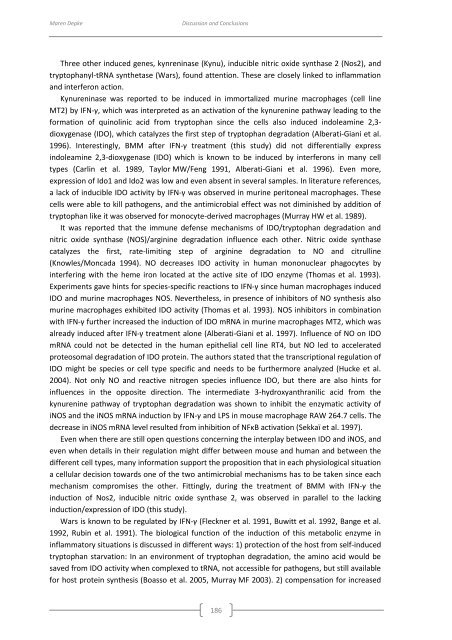genomewide characterization of host-pathogen interactions by ...
genomewide characterization of host-pathogen interactions by ...
genomewide characterization of host-pathogen interactions by ...
You also want an ePaper? Increase the reach of your titles
YUMPU automatically turns print PDFs into web optimized ePapers that Google loves.
Maren Depke<br />
Discussion and Conclusions<br />
Three other induced genes, kynreninase (Kynu), inducible nitric oxide synthase 2 (Nos2), and<br />
tryptophanyl-tRNA synthetase (Wars), found attention. These are closely linked to inflammation<br />
and interferon action.<br />
Kynureninase was reported to be induced in immortalized murine macrophages (cell line<br />
MT2) <strong>by</strong> IFN-γ, which was interpreted as an activation <strong>of</strong> the kynurenine pathway leading to the<br />
formation <strong>of</strong> quinolinic acid from tryptophan since the cells also induced indoleamine 2,3-<br />
dioxygenase (IDO), which catalyzes the first step <strong>of</strong> tryptophan degradation (Alberati-Giani et al.<br />
1996). Interestingly, BMM after IFN-γ treatment (this study) did not differentially express<br />
indoleamine 2,3-dioxygenase (IDO) which is known to be induced <strong>by</strong> interferons in many cell<br />
types (Carlin et al. 1989, Taylor MW/Feng 1991, Alberati-Giani et al. 1996). Even more,<br />
expression <strong>of</strong> Ido1 and Ido2 was low and even absent in several samples. In literature references,<br />
a lack <strong>of</strong> inducible IDO activity <strong>by</strong> IFN-γ was observed in murine peritoneal macrophages. These<br />
cells were able to kill <strong>pathogen</strong>s, and the antimicrobial effect was not diminished <strong>by</strong> addition <strong>of</strong><br />
tryptophan like it was observed for monocyte-derived macrophages (Murray HW et al. 1989).<br />
It was reported that the immune defense mechanisms <strong>of</strong> IDO/tryptophan degradation and<br />
nitric oxide synthase (NOS)/arginine degradation influence each other. Nitric oxide synthase<br />
catalyzes the first, rate-limiting step <strong>of</strong> arginine degradation to NO and citrulline<br />
(Knowles/Moncada 1994). NO decreases IDO activity in human mononuclear phagocytes <strong>by</strong><br />
interfering with the heme iron located at the active site <strong>of</strong> IDO enzyme (Thomas et al. 1993).<br />
Experiments gave hints for species-specific reactions to IFN-γ since human macrophages induced<br />
IDO and murine macrophages NOS. Nevertheless, in presence <strong>of</strong> inhibitors <strong>of</strong> NO synthesis also<br />
murine macrophages exhibited IDO activity (Thomas et al. 1993). NOS inhibitors in combination<br />
with IFN-γ further increased the induction <strong>of</strong> IDO mRNA in murine macrophages MT2, which was<br />
already induced after IFN-γ treatment alone (Alberati-Giani et al. 1997). Influence <strong>of</strong> NO on IDO<br />
mRNA could not be detected in the human epithelial cell line RT4, but NO led to accelerated<br />
proteosomal degradation <strong>of</strong> IDO protein. The authors stated that the transcriptional regulation <strong>of</strong><br />
IDO might be species or cell type specific and needs to be furthermore analyzed (Hucke et al.<br />
2004). Not only NO and reactive nitrogen species influence IDO, but there are also hints for<br />
influences in the opposite direction. The intermediate 3-hydroxyanthranilic acid from the<br />
kynurenine pathway <strong>of</strong> tryptophan degradation was shown to inhibit the enzymatic activity <strong>of</strong><br />
iNOS and the iNOS mRNA induction <strong>by</strong> IFN-γ and LPS in mouse macrophage RAW 264.7 cells. The<br />
decrease in iNOS mRNA level resulted from inhibition <strong>of</strong> NFκB activation (Sekkaï et al. 1997).<br />
Even when there are still open questions concerning the interplay between IDO and iNOS, and<br />
even when details in their regulation might differ between mouse and human and between the<br />
different cell types, many information support the proposition that in each physiological situation<br />
a cellular decision towards one <strong>of</strong> the two antimicrobial mechanisms has to be taken since each<br />
mechanism compromises the other. Fittingly, during the treatment <strong>of</strong> BMM with IFN-γ the<br />
induction <strong>of</strong> Nos2, inducible nitric oxide synthase 2, was observed in parallel to the lacking<br />
induction/expression <strong>of</strong> IDO (this study).<br />
Wars is known to be regulated <strong>by</strong> IFN-γ (Fleckner et al. 1991, Buwitt et al. 1992, Bange et al.<br />
1992, Rubin et al. 1991). The biological function <strong>of</strong> the induction <strong>of</strong> this metabolic enzyme in<br />
inflammatory situations is discussed in different ways: 1) protection <strong>of</strong> the <strong>host</strong> from self-induced<br />
tryptophan starvation: In an environment <strong>of</strong> tryptophan degradation, the amino acid would be<br />
saved from IDO activity when complexed to tRNA, not accessible for <strong>pathogen</strong>s, but still available<br />
for <strong>host</strong> protein synthesis (Boasso et al. 2005, Murray MF 2003). 2) compensation for increased<br />
186

















